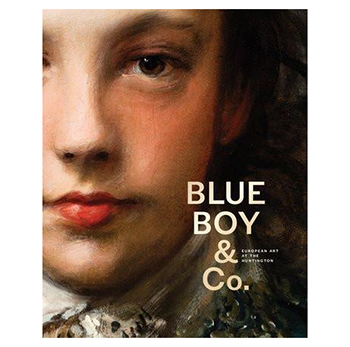Paint Pinky and Blue Boy From Drawing Transfers
One of the most iconic artworks in British and American history, The Blue Boy, made around 1770 by English painter Thomas Gainsborough (1727-1788), underwent its first major technical examination and conservation treatment in public view, in a special satellite conservation studio set up in the west end of the Thornton Portrait Gallery in the Huntington Art Gallery. "Project Blue Boy" offered visitors a glimpse into the technical processes of a senior conservator working on the famous painting as well as background on its history, mysteries, and artistic virtues.
Conservation Schedule
For the first 4–5 months during the year-long exhibition, The Blue Boy was in the gallery as Christina O'Connell, The Huntington's senior paintings conservator, worked on the painting performing examination and analysis, and then paint stabilization, surface cleaning, and removal of non-original varnish and overpaint. The painting then went off-view for four months while she performed structural work on the canvas and applied varnish with equipment that can't be moved to the gallery space. Once structural work was completed, The Blue Boy returned to the gallery where visitors were able to witness the inpainting process until the close of the exhibition in March 2020.
Phase 1: Painting on View Sept. 22, 2018–Feb. 18, 2019
Exam and stabilization of paint, surface cleaning, varnish and overpaint removal
In Gallery Conservator Hours and Gallery Talks
Phase 2: Painting off View Feb. 19–June 18
Lab work: Structural work, new varnish, during-treatment photography
In Gallery Conservator Talks
Phase 3: Painting on View June 19–Sept. 30
Inpainting
In Gallery Conservator Hours and Gallery Talks
Final Phase: Painting off view Oct. 1, 2019–March 26, 2020
Inpainting, varnish, technical study, supportive backing, adjusting framing
No Gallery Conservator Hours or Gallery Talks
Stabilized and restored painting goes on view March 26 in the Thornton Portrait Gallery
More
During the periods when the painting was in the gallery, O'Connell worked in public view on scheduled days. For the first in-gallery period, from Sept. 22, 2018 through mid-Feb., 2019, visitors were able to watch the process during conservator talks on Thursdays and Fridays, and on the first Sunday of each month.
O'Connell used a number of tools during the project, the largest among them a Haag-Streit Hi-R NEO 900 surgical microscope that measures six feet in height. The state-of-the-art device had a long movable arm and optics that can magnify up to 25x, which gave the conservator a detailed view of the painting's surface during the treatment stages, when special adhesives were added to the areas of lifting paint. Many of the conservator's hand tools were showcased, giving visitors a chance to understand the precision inherent in the work.
Structural and Visual Repairs
The Blue Boy required conservation to address both structural and visual concerns. The painting is so important and popular that it has been on almost constant display since The Huntington opened to the public almost 100 years ago. "The most recent conservation treatments have mainly involved adding new layers of varnish as temporary solutions to keep The Blue Boy on view as much as possible," O'Connell said of the project. "The original colors now appear hazy and dull, and many of the details are obscured." According to O'Connell, there were also several areas where the paint is beginning to lift and flake, making the work vulnerable to loss and permanent damage; and the adhesive that binds the canvas to its lining was failing, meaning the painting does not have adequate support for long-term display. These issues and more will be addressed by "Project Blue Boy".
Haag-Streit Surgical Microscope Used
In addition to contributing to scholarship in the field of conservation, the undertaking uncovered new information of interest to art historians. O'Connell used a Haag-Streit surgical microscope to closely examine the painting. To gather material information, she employed imaging techniques including digital x-radiography, infrared reflectography, ultraviolet fluorescence, and x-ray fluorescence. The data from these analytical techniques have contribute to a better understanding of the materials Gainsborough procured to create The Blue Boy while at the same time revealed information about earlier conservation treatments. The project addressed several questions. "One area we'd like to better understand is, what technical means did Gainsborough use to achieve his spectacular visual effects?" said Melinda McCurdy, The Huntington's associate curator for British art and co-curator of the exhibition. "He was known for his lively brushwork and brilliant, multifaceted color. Did he develop special pigments, create new materials, pioneer new techniques?" She and O'Connell built upon clues gleaned from previous conservation projects to learn more. "We know from earlier x-rays that The Blue Boy was painted on a used canvas, on which the artist had begun the portrait of a man," she said. "What might new technologies tell us about this earlier abandoned portrait? Where does this lost painting fit into his career? How does it compare with other portraits from the 1760s?"
Who is The Blue Boy?
Gainsborough was among the most prominent artists of his day. Though he preferred to paint landscapes, he made his career producing stylish portraits of the British gentry and aristocracy. Jonathan Buttall (1752–1805), the painting's first owner, was once thought to have been the model for the painting, but the identity of the subject remains unconfirmed. The young man's costume is significant. Instead of dressing the figure in the elegant finery worn by most subjects of the day, Gainsborough chose knee breeches and a slashed doublet with a lace collar–a clear nod to the work of Anthony van Dyck, the 17th-century Flemish painter who had profoundly influenced British art. The painting first appeared in public in the Royal Academy exhibition of 1770 as A Portrait of a Young Gentleman, where it received high acclaim, and by 1798 it was being called "The Blue Boy"–a nickname that stuck.
Henry Huntington Purchases The Blue Boy for the Highest Price Ever Paid for a Painting
Henry E. Huntington (1850–1927) purchased The Blue Boy in 1921 for the highest price ever then paid for a painting. By bringing a British treasure to the United States, Huntington imbued an already well-known image with even greater notoriety—on both sides of the Atlantic. Before allowing the painting to be transferred to San Marino, art dealer Joseph Duveen orchestrated an international publicity campaign that "rivaled those surrounding blockbuster movies today," said McCurdy. "In its journey from London to Los Angeles, The Blue Boy underwent a shift from portrait to icon, as the focus of a series of limited-engagement exhibitions engineered by Duveen." The image remains recognizable to this day, appearing in works of contemporary art and in vehicles of popular culture—from major motion pictures to velvet paintings.
Six other life-size Grand Manner portraits by Gainsborough line The Thornton Portrait Gallery. They depict composer Karl Friedrich Abel (ca. 1777); Elizabeth (Jenks) Beaufoy, later Elizabeth Pycroft (ca. 1780); Edward, Viscount (later Earl) Ligonier (1770); Penelope (Pitt), Viscountess Ligonier (1770); Juliana (Howard), Baroness Petre (1778); and Henrietta Read, later Henrietta Meares (ca. 1777).
Conservation funded by a grant from the Bank of America Art Conservation Project. Additional generous support for this project was provided by the Getty Foundation, Friends of Heritage Preservation, and Haag-Streit USA.
![]()

The Science Behind Conservation




Saving One of Western Art's Most Iconic Paintings

Video: Eye to Eye with Blue Boy

Los Angeles Times: Exorcising the Ghosts of Art


VERSO: How Do You Frame a Masterpiece?

Blue Boy & Co.: European Art at The Huntington available in the Huntington Store

A blue-themed musical companion to the Project Blue Boy exhibition. Enjoy the sounds and share the playlist with your friends. (A free Spotify account is required to access playlist)
Join today!
JOIN
Source: https://www.huntington.org/project-blue-boy




0 Response to "Paint Pinky and Blue Boy From Drawing Transfers"
Enregistrer un commentaire